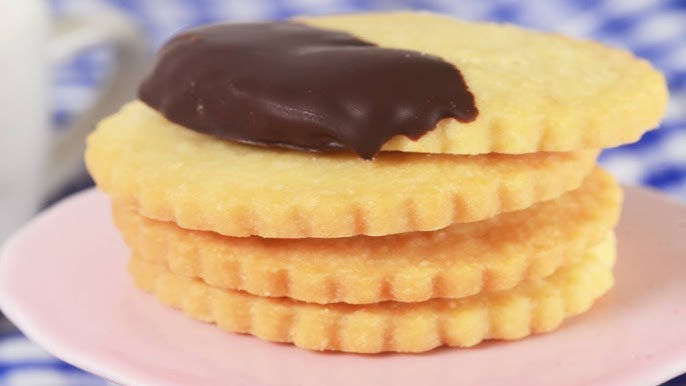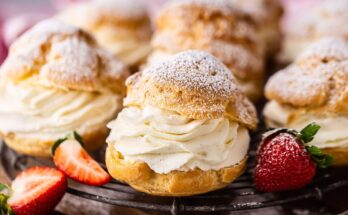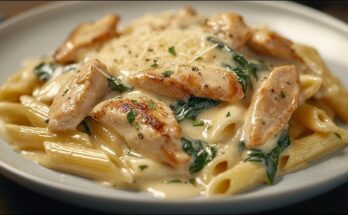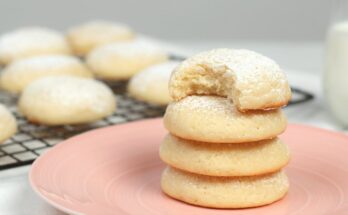Shortbread Cookies Recipe: Shortbread cookies are the epitome of buttery, melt-in-your-mouth goodness. With a delicate crumb and a rich flavor, these cookies are a timeless classic that originated in Scotland. They’re beloved for their simplicity—just three main ingredients—and their versatility. Whether you’re preparing a batch for a holiday party, a cozy tea time treat, or simply to satisfy a sweet craving, shortbread cookies never fail to deliver.
These cookies are all about balance—sweet but not overly sugary, crisp yet tender. While they might look simple, there’s a whole world of technique behind getting that perfect texture. This guide will walk you through everything you need to know to master the art of shortbread, even if you’re baking them for the first time.
Why You’ll Love This Shortbread Recipe
You’ll fall in love with this recipe for a few good reasons. First, it’s foolproof—even if you’re a baking newbie, you’ll find success. Second, it uses ingredients you probably already have in your pantry, so no need for a grocery store run. Lastly, this shortbread comes out perfectly every time: golden edges, a soft but firm bite, and that rich buttery flavor that’s so addictive.
Here’s why it stands out:
- Minimal Ingredients: You only need three core items—flour, butter, and sugar.
- Customizable: Add lemon zest, chocolate chips, or even rosemary to spice things up.
- Make-Ahead Friendly: The dough can be prepped ahead and baked later.
- Great for Gifting: These cookies pack and ship beautifully, making them perfect for holiday or birthday gifts.
This isn’t just a cookie—it’s a baking ritual that soothes your soul.
Ingredients You’ll Need
The beauty of shortbread lies in its simplicity. You need just a few ingredients, but quality is key:
- 1 cup (2 sticks) unsalted butter, softened
- 1/2 cup powdered sugar (not granulated)
- 2 cups all-purpose flour
- 1/2 teaspoon vanilla extract (optional)
- Pinch of salt (if using unsalted butter)
That’s it! No eggs, no baking powder, no fuss.
Choosing Quality Ingredients
Since there are only three main ingredients, each one plays a big role in flavor and texture.
- Butter: This is the star. Use high-quality unsalted butter. European-style butter with higher fat content gives the richest flavor.
- Sugar: Powdered sugar gives a smoother texture than granulated. It also melts better into the butter.
- Flour: Standard all-purpose flour works just fine. Don’t use bread flour or cake flour.
Vanilla extract is optional but recommended for a subtle depth of flavor.
Tools Required for Perfect Shortbread Cookies
You don’t need a full bakery to whip up a great batch of shortbread cookies. Here’s what you’ll want on hand:
- Mixing bowls
- Hand mixer or stand mixer
- Rubber spatula
- Measuring cups and spoons
- Rolling pin (if rolling dough)
- Cookie cutters (optional)
- Baking sheet
- Parchment paper
These basic tools help keep things neat and efficient. If you want picture-perfect cookies, invest in a cookie press or a shortbread pan for added flair.
Step-by-Step Instructions
Let’s get down to the baking. Here’s your roadmap to buttery shortbread perfection.
Step 1: Prepare the Ingredients
Start by letting the butter soften to room temperature. This is crucial—it needs to be soft enough to cream but not melted. Pre-measure your flour and sugar for a smooth process.
Pro tip: Sift your powdered sugar and flour to prevent clumps.
Step 2: Cream the Butter and Sugar
In a large bowl, beat the softened butter and powdered sugar together until light and fluffy. This takes about 2-3 minutes with a mixer. You’re not just combining them—you’re adding air for a tender crumb.
Add the vanilla extract now if you’re using it. Mix just until combined.
Step 3: Add the Flour
Gradually add the flour to the butter mixture. You can do this in two or three batches to avoid a flour explosion. Mix until the dough just comes together. Don’t overmix—it can make the cookies tough.
At this point, the dough should be soft but not sticky. If it’s too dry, add a teaspoon of milk. If too sticky, sprinkle in a little extra flour.
Step 4: Chill the Dough
Wrap the dough in plastic wrap and chill it for at least 30 minutes. This helps the cookies hold their shape and gives the butter time to firm up again.
Want to prep ahead? The dough can be stored in the fridge for up to 3 days or frozen for 2 months.
Step 5: Shape and Bake
Preheat your oven to 325°F (165°C). Roll out the dough to about 1/4-inch thickness on a floured surface. Cut into shapes or simply slice into rectangles.
Place cookies on a baking sheet lined with parchment paper. Prick each cookie with a fork for that traditional shortbread look and to release steam during baking.
Bake for 12-15 minutes or until the edges are just turning golden. Let them cool on the sheet for 5 minutes before transferring to a wire rack.
They’ll firm up as they cool—so don’t worry if they feel a little soft out of the oven.
Tips for Perfect Shortbread Cookies
If you’ve ever wondered why some shortbread cookies turn out chewy instead of crisp, or why they spread too much, these expert tips will steer you toward perfection every time:
- Don’t skip chilling the dough: This helps the cookies retain their shape and prevents spreading in the oven.
- Use real butter: Margarine won’t cut it here. Butter is key to that rich flavor and crumbly texture.
- Avoid overworking the dough: The more you knead or stir, the tougher your cookies will be. Handle it just enough to bring everything together.
- Uniform thickness is key: Uneven dough means some cookies will bake faster than others, leading to burnt or undercooked results.
- Cool before moving: Shortbread is fragile straight out of the oven. Let it rest a few minutes before transferring it to a cooling rack.
Little tweaks make a big difference. Once you’ve nailed these, your cookies will have that melt-in-your-mouth texture every single time.
Flavor Variations to Try
Shortbread is like a blank canvas. Once you’ve got the basic recipe down, it’s time to get creative. Here are some flavor ideas to elevate your shortbread game:
- Lemon Zest and Poppy Seeds: Add 1 tsp lemon zest and 1 tbsp poppy seeds for a citrusy twist.
- Chocolate-Dipped: After baking, dip half of each cookie in melted dark or white chocolate. Add sprinkles or sea salt for extra flair.
- Lavender and Honey: A teaspoon of dried culinary lavender and a tablespoon of honey infuse the cookies with floral notes.
- Spiced Chai Shortbread: Mix in cinnamon, cardamom, nutmeg, and ginger for a cozy spice blend.
- Almond Shortbread: Swap out a quarter of the flour for almond flour and add a few drops of almond extract.
Don’t be afraid to experiment with your pantry. You can tailor shortbread cookies to any season, event, or flavor craving.
How to Store Shortbread Cookies
Shortbread cookies store beautifully, which makes them great for make-ahead baking or gifting. Here’s how to keep them fresh:
- Room Temperature: Store in an airtight container for up to 1 week. Place parchment between layers to avoid sticking.
- Refrigerator: They can last up to 2 weeks if sealed well.
- Freezer: Freeze baked cookies for up to 2 months. To freeze the dough, shape it into a log, wrap tightly, and slice and bake as needed.
When freezing baked cookies, let them thaw at room temp before serving. If you want them slightly warm, pop them in the oven at 300°F for 5 minutes to revive their crisp texture.
Common Mistakes and How to Avoid Them
Even a simple recipe like shortbread has a few potential pitfalls. Here’s what to watch out for:
- Using cold butter: It won’t cream properly, and your cookies may turn out dense.
- Skipping the chilling step: The dough needs time to rest. Without it, the cookies will spread too much.
- Overbaking: Shortbread should be pale with just the faintest golden edge. If it’s too brown, it’ll taste burnt.
- Measuring flour incorrectly: Always spoon flour into the measuring cup and level it with a knife. Scooping straight from the bag can lead to packed flour and dry cookies.
- Not creaming butter and sugar long enough: This step adds air, giving your cookies a lighter texture.
Fixing these simple missteps will help you bake flawless cookies every time.
Nutritional Information (Per Cookie)
This can vary based on the size and any added ingredients, but here’s a general idea for a standard 2-inch round shortbread cookie:
| Nutrient | Amount |
|---|---|
| Calories | 120 |
| Total Fat | 7g |
| Saturated Fat | 4.5g |
| Cholesterol | 20mg |
| Sodium | 50mg |
| Total Carbohydrate | 13g |
| Sugars | 4g |
| Protein | 1g |
Keep in mind, if you add extras like chocolate or nuts, these numbers will increase. Always adjust if you’re following specific dietary guidelines.
Serving Suggestions
Shortbread cookies are incredibly versatile when it comes to serving. Whether you’re keeping it classic or going for a little flair, here are some delightful ways to enjoy your batch:
- With Tea or Coffee: Shortbread and a warm cup of tea or coffee is a timeless duo. Their buttery flavor pairs perfectly with Earl Grey, chamomile, or even a robust espresso.
- As a Dessert Base: Crumble your shortbread to make an irresistible base for cheesecakes or trifles. Their firm, crumbly texture is ideal for crusts.
- Dipped and Decorated: For holidays or celebrations, dip half of each cookie in chocolate, then top with crushed nuts, dried fruit, or sprinkles. It makes for a festive and tasty presentation.
- With Ice Cream: Sandwich some vanilla bean or salted caramel ice cream between two shortbread cookies. A grown-up version of the ice cream sandwich—rich, crunchy, and totally satisfying.
- Gifting in Tins: Place your cookies in decorative tins lined with parchment paper for a homemade gift that looks and tastes luxurious.
Shortbread doesn’t need much to shine. Its classic simplicity is often the star, but these serving ideas give it just the right touch of extra.
FAQs about Shortbread Cookies Recipe
1. What ingredients do I need for shortbread cookies?
For classic shortbread cookies, you need just three main ingredients: butter, sugar, and flour. Optional additions include salt, vanilla extract, or almond essence to enhance the flavor.
2. How long should I bake shortbread cookies?
Shortbread cookies typically bake at 325°F (160°C) for about 15 to 20 minutes. The key is to look for a slight golden color around the edges; they should not brown all over.
3. Do I need to chill the dough before baking?
Yes, chilling the dough is crucial. It helps prevent the cookies from spreading too much and maintains their classic, crisp texture. Chill the dough for at least 30 minutes before rolling and cutting.
4. Can I make shortbread cookies without a mixer?
Absolutely! You can easily mix the dough by hand, using a wooden spoon or even just your fingertips. The warmth of your hands helps soften the butter, making it easier to incorporate the flour and sugar.
5. Are shortbread cookies suitable for vegans?
Traditional shortbread recipes include butter, but you can substitute vegan butter to make vegan-friendly cookies. Ensure the sugar and any flavorings used are also vegan.
6. How can I store shortbread cookies?
Store shortbread cookies in an airtight container at room temperature. They can last for up to 3 weeks. For longer storage, you can freeze the dough or baked cookies for up to 3 months.
7. Can I add chocolate to my shortbread cookies?
Yes, you can! Dip half of each cookie in melted chocolate or drizzle chocolate over the top for a delicious twist. Allow the chocolate to set before serving.
These FAQs aim to make your baking experience easier and ensure that your shortbread cookies come out perfectly every time. Enjoy baking and indulging in your homemade treats!



